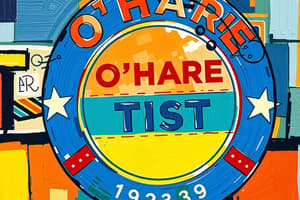Podcast
Questions and Answers
What indicates that a civilian airport beacon is operating?
What indicates that a civilian airport beacon is operating?
- Two flashes of white alternating with green lights
- Alternating white and green lights (correct)
- Flashing white and yellow lights
- Alternating white and red lights
Under what conditions would an airport beacon operate during daytime?
Under what conditions would an airport beacon operate during daytime?
- Only when the ceiling is over 2,000 feet
- During all daytime operations regardless of weather
- When the visibility is more than 5 statute miles
- If the ceiling is less than 1,000 feet or visibility less than 3 statute miles (correct)
What visual indicator system uses alternating colors to assist pilots in landing?
What visual indicator system uses alternating colors to assist pilots in landing?
- Precision Approach Path Indicator (PAPI)
- Tri-Color Visual Approach Slope Indicator
- Pulsating Visual Approach Slope Indicator (PVASI)
- Visual Approach Slope Indicator (VASI) (correct)
Which airport's beacon uses flashing white and yellow lights?
Which airport's beacon uses flashing white and yellow lights?
What is the function of an approach light system?
What is the function of an approach light system?
How many lights are used in a Precision Approach Path Indicator (PAPI)?
How many lights are used in a Precision Approach Path Indicator (PAPI)?
What type of lighting indicates an airport's threshold?
What type of lighting indicates an airport's threshold?
What does a Tri-Color VASI use to project its visual path?
What does a Tri-Color VASI use to project its visual path?
What color lights are used in the last 1,000 feet of the runway?
What color lights are used in the last 1,000 feet of the runway?
What do the taxiway edge lights indicate?
What do the taxiway edge lights indicate?
How are the touchdown zone lights configured?
How are the touchdown zone lights configured?
What type of lighting is typically used for obstruction warning?
What type of lighting is typically used for obstruction warning?
What function do the taxiway lead-off/on lights serve?
What function do the taxiway lead-off/on lights serve?
What happens to the runway centerline lighting as it approaches the last 3,000 feet?
What happens to the runway centerline lighting as it approaches the last 3,000 feet?
Flashcards are hidden until you start studying
Study Notes
Airport Lighting Overview
- Airport beacons guide pilots to lighted airports at night.
- Beacons typically inactive during the day, except when ceiling is below 1,000 feet or visibility is less than 3 statute miles.
Types of Airport Beacons
- Civilian airports feature alternating white and green lights.
- Water airports utilize flashing white and yellow lights.
- Military airports display two flashes of white alternating with a single green light.
- Heliports use alternating green, yellow, and white lights.
Visual Glide Slope Indicators
- Light systems indicate position in relation to the desired glide path to the runway.
- Located on the sides of basic or instrument runways; usable for both day and night approaches.
Visual Approach Slope Indicator (VASI)
- VASI shows if the aircraft is on a safe glide path to the runway's touchdown zone.
- Available in configurations with either 2 or 3 bars.
Tri-Color VASI
- Projects a three-color visual path using a single light unit.
Pulsating Visual Approach Slope Indicator (PAPI)
- Projects a two-color visual approach path into the final approach area.
- Also referred to as Pulse Light Approach Slope Indicator (PLASI).
Approach Light System
- Aids instrument pilots in transitioning to visual references after an instrument approach.
- Light systems can begin up to 3,000 feet from the extended runway centerline, featuring a mix of steady and flashing lights.
Runway Lighting Components
- Runway edge lights are a single row of white lights along runway edges, with green lights marking the start and red marking the end.
- Runway End Identifier Lights (REIL) use high-intensity white strobe lights to mark thresholds.
Runway Centerline Lighting System (RCLS)
- White lights continue until the last 3,000 feet of the runway.
- From 3,000 to 1,000 feet, alternating red and white lights are utilized.
- Last 1,000 feet has red-only lights.
Touchdown Zone Lights
- Consist of two rows of transverse light bars on either side of the runway centerline.
- Start at 100 feet from the threshold, extending to the midpoint of the runway or to 3,000 feet, whichever is less.
Taxiway Lighting
- Taxiway edge lights are blue omnidirectional lights lining both edges of the taxiway, guiding from the runway to the ramp area.
- Taxiway lead-off/on lights assist in entering/exiting the taxiway or active runway.
Obstruction Lighting
- Provides advance warning of prominent structures, such as towers and buildings.
- Typically uses bright red and high-intensity white lights, with possible use of flashing lights.
Pilot-Controlled Lighting
- Allows pilots to activate or control certain lighting systems on the airport as needed.
Studying That Suits You
Use AI to generate personalized quizzes and flashcards to suit your learning preferences.




